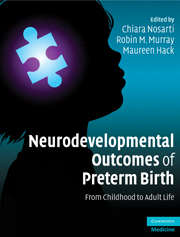19 - Integrative summary and future directions
from Section 6 - Conclusions
Published online by Cambridge University Press: 06 July 2010
Summary
Whilst preterm birth represents the single largest factor worldwide in terms of infant mortality [1], mortality rates associated with preterm birth have decreased in recent decades thanks to advances in perinatal and neonatal care [2, 3]. However, the improved survival of very preterm and very low birth weight infants has been associated with an increase in the prevalence of neonatal problems (including periventricular hemorrhage, chronic lung disease, retinopathy of prematurity (ROP), and septicemia) and neurodevelopmental sequelae [4]. Therefore, attention has increasingly focused on the quality of life of survivors, who are at greater risk of brain damage and consequent neurological disorders, and neuropsychological and behavioral impairments in childhood and later in life [5–8].
In this volume, leading experts from multiple disciplines, investigating various aspects of the long-term consequences of very preterm birth, have presented a comprehensive and updated summary of research in their field. As well as extending existing knowledge of the neurodevelopmental sequelae following very preterm birth, a shared aim of this burgeoning body of research is to identify the mechanisms underlying variations in outcome and thus recognize subgroups of children who are at increased risk of neurodevelopmental problems, who can then be referred early to appropriate intervention services.
Preterm birth occurs in a substantial percentage of the population: just less than 13% of US live births are reported as being preterm (< 37 completed weeks of gestation). Very preterm births, occurring before 32 completed gestational weeks, account for about 15% of preterm births, which is equivalent to 1–2% of all pregnancies [9].
- Type
- Chapter
- Information
- Neurodevelopmental Outcomes of Preterm BirthFrom Childhood to Adult Life, pp. 251 - 264Publisher: Cambridge University PressPrint publication year: 2010



